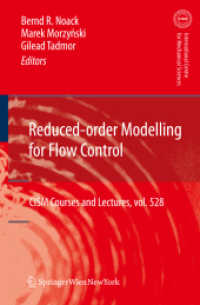Full Description
The worldwide cancer burden will double over the next two decades, with the number of new cancer diagnoses increasing in all regions of the world. However, it is estimated that around 40% of all cancers are preventable through the appropriate application of existing epidemiological and public health knowledge, and with further research this proportion will increase considerably. This edited volume explores the role of place in cancer prevention and how geospatial tools can be used to support this globally important goal. Its chapters detail many aspects of the application of geospatial science to cancer control, including quantifying exposure to environmental carcinogens, access to screening services, the importance of partnership building, and more through a variety of geographically diverse case studies. The book also offers background on geospatial modeling tools and methods for adding spatial analysis to cancer surveillance systems. The book is rooted firmly in the notion that geography significantly influences the accumulation of cancer risks (at the individual and community level) that are modifiable through policy, regulatory, and behavioral changes.
The landscape of cancer prevention is vast, encompassing the building blocks of population and public health—i.e., epidemiology and causation—through risk factor modifications, behavior and policy change, to the interface of the cellular with society, including epigenetic modifications and gene/environment interactions, cancer genomics and precision medicine/health. It is clear that geography (space, place, setting, context) is central to all these activities. Geospatial methods and data support risk factor identification, can elucidate the interaction between individual behavioral, demographic, and genetic factors with community level contextual factors, and can be used to prioritize interventions more accurately towards at-risk people and at-risk population groups. Geography is also central to the organization of health services and hence, by definition, is fundamental to the organization of preventative services. More broadly, adopting a geographical approach can help move cancer prevention beyond a narrow medical definition of health, to tackle the upstream and structural determinants of cancer.
Contents
Chapter 1. Introduction: People, Place, Cancer.- Chapter 2. Cancer Prevention: Principles and Approaches.- Chapter 3. Current State of Geospatial Approaches in Cancer Prevention Worldwide.- Chapter 4. Geospatial Science and Health: Overview of Data and Methods.- Chapter 5. Cohort Studies and Context: Infrastructure to Support Cancer Prevention.- Chapter 6. Applying Spatial Analysis Functionality to Enhance Routine Cancer Surveillance Systems.- Chapter 7. Not Only Smoking: Preventing Lung Cancers Caused by Environmental Exposures.- Chapter 8. Place-Based Approaches to Tobacco Control in China.- Chapter 9. The Nova Scotia Community Cancer Matrix: Small-Area Spatiotemporal Estimation of Local Patterns of Cancer Co-Occurrence, Risk and Inequity.- Chapter 10. Situating People and Place in Cancer Prevention: Arsenic in Drinking Water in Global to Local Context.- Chapter 11. The Development of the Australian Cancer Atlas: Understanding the Geography of Cancer.- Chapter 12. Understanding the Role of Place in Breast and Cervical Cancer Screening in Kenya and Ghana.








